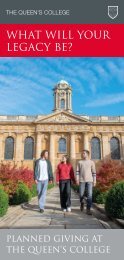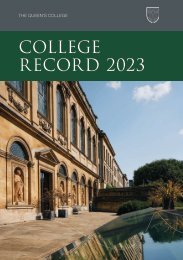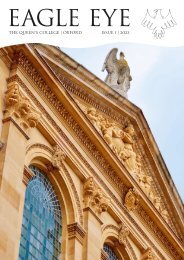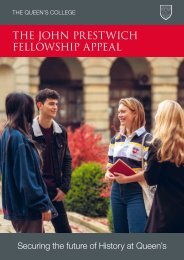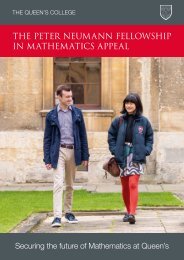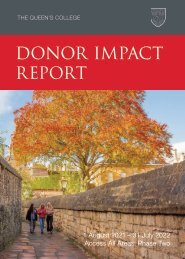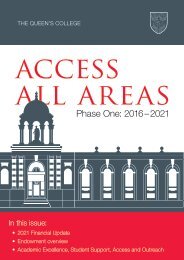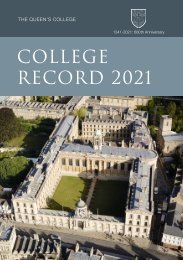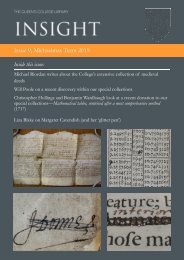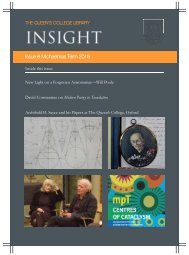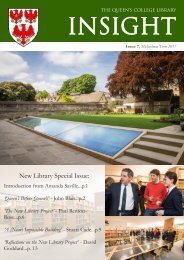The College Record 2022
You also want an ePaper? Increase the reach of your titles
YUMPU automatically turns print PDFs into web optimized ePapers that Google loves.
This stated that fellows were to be elected by open examination, and though the<br />
first to be elected happened to be from Cumbria, the second was not, and he was<br />
followed by JR Magrath who hailed from Guernsey, and would later be provost for 53<br />
years. <strong>The</strong> monopoly of Cumberland and Westmoreland on the <strong>College</strong>’s fellowships<br />
was broken forever.<br />
Though the Two Counties had a stranglehold on the fellowship, the <strong>College</strong> as a<br />
whole developed a wider Northern aspect in the 18th century. In the 1720s Provost<br />
Joseph Smith persuaded Lady Betty Hastings to make a significant contribution to<br />
the <strong>College</strong>. Daughter of the earl of Huntingdon, she was a Northern lady known for<br />
her evangelical piety and charity. She was keen to establish scholarships that would<br />
support men from the North of England who would become missionaries, but Smith<br />
managed to persuade her to instead support men who would merely be ordained.<br />
So, she gave the <strong>College</strong> her manor of Wheldale, now subsumed into Castleford,<br />
which proved to be a lucky bequest when a rich seam of coal was discovered<br />
beneath the land in the 19th century.<br />
Articles<br />
<strong>The</strong> system laid down by Lady Betty for electing her scholars, odd though it seems<br />
today, reflects her character. She nominated twelve schools (eight from Yorkshire and<br />
two each from Cumberland and Westmoreland) who, every five years, could send<br />
their best pupil to the inn at Aberford, near Leeds. <strong>The</strong>re they would be examined<br />
by a group of clergy who whittled their number down to ten. <strong>The</strong> Provost and a few<br />
fellows then examined the remainder and reduced them to eight. <strong>The</strong>se eight best<br />
pupils then had their names put into a pot and the first five names to be drawn were<br />
elected Hastings Scholars! Lady Betty observed in her codicil that drawing lots like<br />
this ‘may be called by some superstitious’ but she preferred to believe it ‘as leaving<br />
something to Providence’. This system continued until as late as 1861.<br />
<strong>The</strong>re is one more aspect to the <strong>College</strong>’s northern connections, and that is in its<br />
capacity as a landowner. On founding the <strong>College</strong>, Robert de Eglesfield gave the<br />
<strong>College</strong> his estate in Ravenwyk. Now known as Renwick, it is not far from his putative<br />
birthplace. <strong>The</strong> residential property in Renwick has been sold, but the <strong>College</strong> still<br />
owns a farm in the village and is Lord of the Manor. But owning property at the<br />
country’s extremities could be dangerous. A small estate in Bowness-on-Solway,<br />
a little to the north-west of Carlisle had been acquired in 1416, but just three years<br />
later, the accounts reveal that no income could be collected due to the ‘devastation<br />
of the Scots’.<br />
We come full circle with a gift from an Old Member, Percy Wyndham. He had come<br />
up to Queen’s in 1886 as an Eglesfield Scholar, and it may well be that association<br />
which led him in 1895, not long after going down, to purchase Moorland Close Farm<br />
in Eaglesfied, the Cumberland village from which the founder’s family presumably<br />
originated. In his will of 1947 he left it to the <strong>College</strong>, giving us another property<br />
associated with the founder.<br />
<strong>College</strong> <strong>Record</strong> <strong>2022</strong> | <strong>The</strong> Queen’s <strong>College</strong> 95






